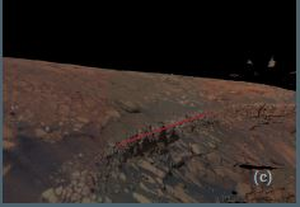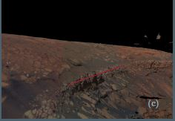Information
- Publication Type: Bachelor Thesis
- Workgroup(s)/Project(s):
- Date: May 2019
- Date (Start): 10. December 2018
- Date (End): 5. May 2019
- Matrikelnummer: 00510453
- First Supervisor: Eduard Gröller

Abstract
3D visualizations of Mars enable scientists to explore the Martian surface in great detail and play an essential role in planetary science, mission planning, and the communication of scientific findings. Due to the unfamiliar environment depicted in these visualizations, conveying a sense of scale is necessary. In this thesis, we characterize the problem space of conveying scale in 3D visualizations of Mars projected onto a 2D screen and design
representations that satisfy the requirements of specific use cases. We discuss challenges posed by different types of scale, magnitudes of scale, use cases, and levels of expertise.
The designed representations include scale-bars, scale-boxes, known-object comparison,
true-layer-thickness, contour-lines, vertical exaggeration, distance shading, and landing ellipses. We received informal feedback for each representation from a planetary scientist and conducted an experiment for known-object comparison with 20 non-experts. The feedback suggests that our representations are capable of conveying a sense of scale in 3D visualizations of Mars for their specific use cases.
Additional Files and Images
Additional images and videos
Additional files
Weblinks
No further information available.
BibTeX
@bachelorsthesis{Riegelnegg_2019,
title = "Conveying a Sense of Scale in 3D Planetary Environments",
author = "Martin Riegelnegg",
year = "2019",
abstract = "3D visualizations of Mars enable scientists to explore the
Martian surface in great detail and play an essential role
in planetary science, mission planning, and the
communication of scientific findings. Due to the unfamiliar
environment depicted in these visualizations, conveying a
sense of scale is necessary. In this thesis, we characterize
the problem space of conveying scale in 3D visualizations of
Mars projected onto a 2D screen and design representations
that satisfy the requirements of specific use cases. We
discuss challenges posed by different types of scale,
magnitudes of scale, use cases, and levels of expertise. The
designed representations include scale-bars, scale-boxes,
known-object comparison, true-layer-thickness,
contour-lines, vertical exaggeration, distance shading, and
landing ellipses. We received informal feedback for each
representation from a planetary scientist and conducted an
experiment for known-object comparison with 20 non-experts.
The feedback suggests that our representations are capable
of conveying a sense of scale in 3D visualizations of Mars
for their specific use cases.",
month = may,
address = "Favoritenstrasse 9-11/E193-02, A-1040 Vienna, Austria",
school = "Research Unit of Computer Graphics, Institute of Visual
Computing and Human-Centered Technology, Faculty of
Informatics, TU Wien ",
URL = "https://www.cg.tuwien.ac.at/research/publications/2019/Riegelnegg_2019/",
}

 Bachelor Thesis
Bachelor Thesis image
image

